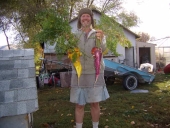




"The rule of no realm is mine. But all worthy things that are in peril as the world now stands, these are my care. And for my part, I shall not wholly fail in my task if anything that passes through this night can still grow fairer or bear fruit and flower again in days to come. For I too am a steward. Did you not know?" Gandolf
 3
3




We come from the Earth, We return to the Earth, and in between we Garden...




Cw Floyd wrote:Marco,
In my past limited experience with fire blight, it is highly contagious for those plants most susceptible. In my observations synthetic fertilizers, excess moisture causing unnaturally fast growth seem to trigger fire blight outbreaks the most. I now practice mostly the S.T.U.N. method (sheer, total, utter, neglect) as far as my plantings and guilds go. I have found it far easier to let Mother Nature decide what will thrive or perish. I know this sounds a bit harsh, but planting fire blight resistant varieties was my ultimate option. Too much valuable time and energy is wasted trying to get ill plants to barely thrive unless constantly attended to, this was stealing my joy piece by piece! If you have managed to not be attacked yet, then I commend you and feel you are doing all the right moves! Trust in yourself and hold true to your path - good soil, good guilds, (I love comfrey) everything you are presently doing in my opinion will be your best defense. I wish I could suggest a magic bullet, but I believe a good rich living soil is the ultimate defensive weapon - best of luck my friend!
"The rule of no realm is mine. But all worthy things that are in peril as the world now stands, these are my care. And for my part, I shall not wholly fail in my task if anything that passes through this night can still grow fairer or bear fruit and flower again in days to come. For I too am a steward. Did you not know?" Gandolf
 1
1




 4
4




 2
2




 2
2




We come from the Earth, We return to the Earth, and in between we Garden...
 2
2




 2
2




Ken W Wilson wrote:I mostly agree with the previous responses but want to add that organic fertilizer is a problem too. New growth is more susceptible, so the slower the tree grows the better. I lost a pear and several apples. The chicken tractor was not directly under them, but too close.
I think standard sized trees can stand more infection.
We come from the Earth, We return to the Earth, and in between we Garden...
 1
1




"The rule of no realm is mine. But all worthy things that are in peril as the world now stands, these are my care. And for my part, I shall not wholly fail in my task if anything that passes through this night can still grow fairer or bear fruit and flower again in days to come. For I too am a steward. Did you not know?" Gandolf

|
Every plan is a little cooler if you have a blimp. And a tiny ad.
The new purple deck of permaculture playing cards
https://www.kickstarter.com/projects/paulwheaton/garden-cards
|



